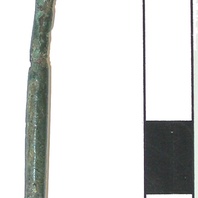
Viking Objects
Expanded-Head Pin (1986/975-AE86)
A copper-alloy pin found at the site of the Little Chester Roman fort. This loose find was found on top of a Roman metalled surface. It has a lozenge-shaped head that is typically Anglo-Scandinavian, but the lack of a secure finds context and its proximity to a Roman surface indicates that it could be Roman.
Read More
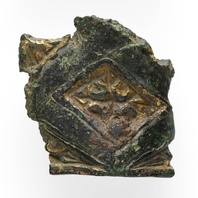
Viking Objects
Broken Gilt Vessel (CM.1822.2008)
A broken gilt vessel fragment decorated with a Carolingian motif within a repeated diamond pattern. A single iron rivet provides evidence that this vessel might have been repaired and reused. The vessel will have been brought from Francia to Torksey, Lincolnshire, where it was found, perhaps by a member of the Great Heathen Army or its train.
Read More
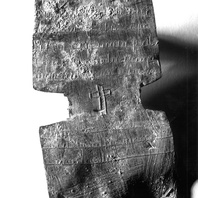
Viking Objects
Inscribed Lead Plaque (LCNCC:1996.64.045)
This lead plaque of uncertain function has a cross incised in its centre and a long Latin text in the Roman alphabet. Like the Saltfleetby spindle whorl, this inscription, too, calls on a divine power, in this case Christ. Between them the two inscriptions represent different responses to literacy and religion in the same time period in neighbouring but probably different communities. (Cumberworth is about 15 miles south of Saltfleetby, in an area with many Scandinavian place-names.) This fragmentary inscription begins with a cross and XPI, the sign for Christ, and after a gap in the text ends with ‘he who by the power of the cross redeemed the world from death, shattered hell or threw open heaven’. The object is dated to the late 10th or 11th century on the basis of the similarity of the writing to contemporary manuscripts.
Read More
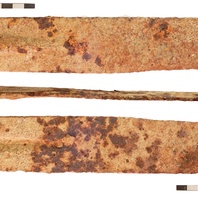
Viking Objects
Scythe (NLM-739C96)
Scythes such as this one would have been common agricultural implements. Dr Kevin Leahy comments that while the scythe has a similar shape to other early medieval examples, the lack of a typical bent tang leaves its dating in question.
Read More
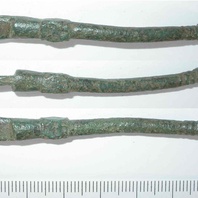
Viking Objects
Scale Arm Fragment (DENO-0619F7)
Folding balances of the type to which this arm belongs are known from the late Anglo-Saxon period and are quite common from the medieval period. The dating of this artefact is therefore somewhat problematic. Scales were a common commerical tool and would have been an important part of any exchange whether using a monetary system or a bullion system, such as the one that existed in Viking-occupied areas of England.
Read More
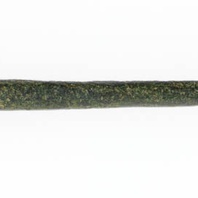
Viking Objects
Needle (CM. 1844-2008)
A cylindrical copper-alloy needle with a circular eye punched into a flattened section. Needles were a common textile tool and could be made from bone, metal or wood. They are generally considered to indicate the presence of female craftspeople, reinforcing the view that the Viking camp at Torksey was inhabited by women and children as well as the warriors of the Great Heathen Army.
Read More
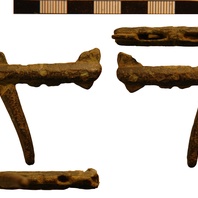
Viking Objects
Folding Arm Pivot Fragment (NLM-6A2893)
Scales were a common commerical tool and would have been an important part of any exchange whether using a monetary system or a bullion system, such as the one that existed in Viking-occupied areas of England.
Read More
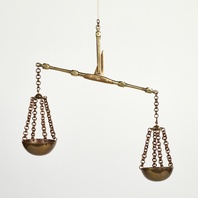
Viking Objects
Reproduction Scales
Scale pan set in copper alloy based on fragments of an arm from Cromwell, Nottinghamshire (DENO 0619F7), a pivot from Northope, Lincolnshire (NLM 6A2893), and a suspension arm and pans based on originals from York and St Peter’s Street, Northampton. Scales were a common commercial tool and would have been an important part of any exchange whether using a monetary system or a bullion system such as the one that existed in Viking-occupied areas of England.
Read More
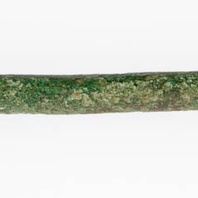
Viking Objects
Copper-Alloy Needle (CM. 1845-2008)
A cylindrical copper-alloy needle fragment with a broken shaft. Needles were a common textile tool and could be made from bone, metal or wood. They are usually associated with women and finds like this indicate that the inhabitants of the Viking camp at Torksey included women and children alongside the warriors of the Great Heathen Army.
Read More
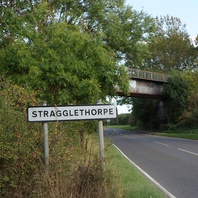
Viking Names
Stragglethorpe
Stragglethorpe, in the Bingham Wapentake of Nottinghamshire, is a hamlet whose name is first recorded in the late eighteenth century. While it does contain the Old Norse element þorp ‘outlying farm, settlement’, it is not clear that the name is as old as the Scandinavian settlement of the region. It has been suggested that it is a name of the late nickname type, referring to an area with a few small straggling farms.
Read More
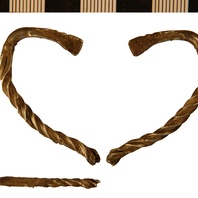
Viking Objects
Silver Arm-Ring (NLM-1B89B2)
This arm-ring fragment is made from strands of wire wound together into a single twisted or cabled strand with a cast zoomorphic terminal. This object was considered together with a group of fragments of ingots and hack-silver of probably contemporary date which were found nearby (NLM-1B0476). However, the mass of this object did not correspond closely to any of the systems of measurement thought to have been used for bullion transactions at that time. The Vikings arriving in England had a bullion economy where they paid for goods with silver that was weighed to an amount agreed between the buyer and the seller. Hacksilver and silver ingots are the most common evidence for their bullion economy. It took some time for the Scandinavian settlers to adopt a monetary economy like that of the Anglo-Saxons, and both systems were used simultaneously for a while before they fully adopted the new system. They were familiar with monetary economies but they treated coins as just another form of silver before adoption of a monetary economy
